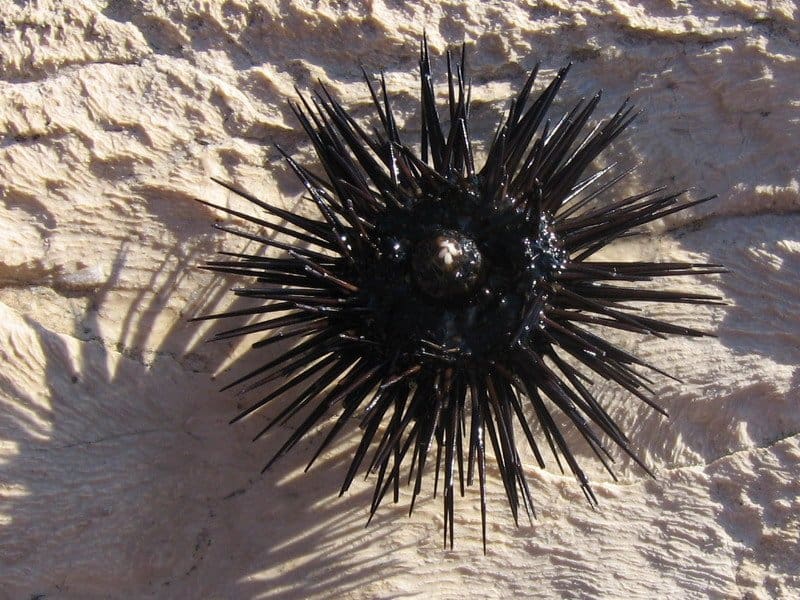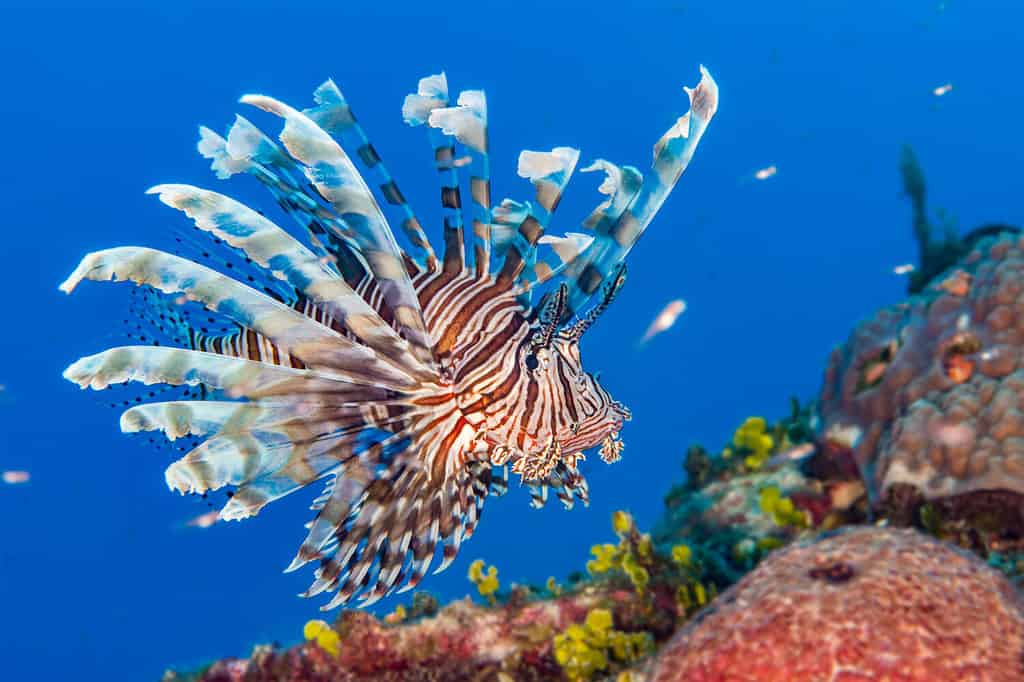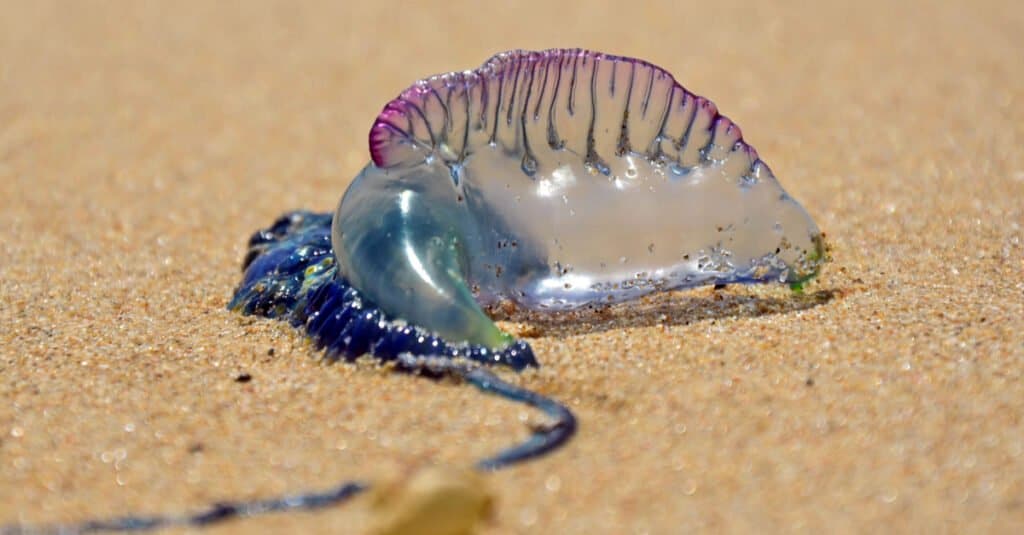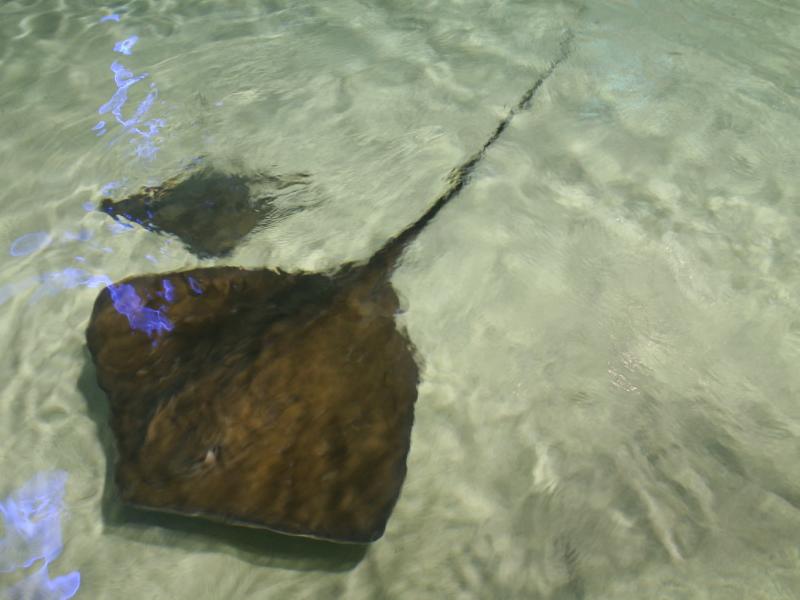Some of the most dangerous animals in New York aren’t in the 63% of forest coverage throughout the state of New York. They’re in the Atlantic Ocean, along the 520 miles of New York coastline. Whenever New York enters the conversation, most people think of a metropolis, thanks to New York City.
The reality is that New York has a reasonably sizeable coastline and much of the state is rural, while most of it is heavy forest. Sure, timber rattlesnakes, snapping turtles, and bull moose are New York animals that are dangerous to humans. But people tend to be less afraid of the dangers they can see.
When it comes to the water, the unseen foe is the true terror and, since these animals dominate the water in ways we never can, are far more dangerous than their land-loving counterparts. With that being said, here is our list of the most dangerous animals swimming in New York’s waters, along the Atlantic coast.
1. Sharks

Sand
tiger shark
(Carcharias taurus) swimming with other fish.
©Valeri Potapova/Shutterstock.com
We’re sticking with the generic term here because there are several species of shark in the Atlantic Ocean, especially close to New York. In fact, a recent AP report reveals that shark sightings along New York’s shorelines are increasing in frequency.
Most of the sightings take place near Long Island but, if sharks are swimming around Long Island, they’re swimming along the entire coastline. Unless you’re scuba diving, your experience with sharks or shark sightings narrows to a few species, including dusky sharks and sandbar sharks.
Occasionally, a sand tiger will make its way close to the shoreline, at least close enough for a sighting. In 2022, there weren’t many shark attacks in New York, though there were enough to make some think twice about hitting up the beach during the summer. There were more than 90 shark attacks worldwide in 2022, with only a handful in New York or the surrounding areas.
Sharks often make their way closer to shore and the worst time for people to hit the water is during the low tide. While the tide is low, sharks get caught between the beach and sandbars farther out. Sometimes, this panics them and they’re more prone to bite anything that crosses their path.
2. Sea Urchin

Sea Urchin
on the beach.
©Lacen – Public Domain
The lowly sea urchin sounds so tame and mild in comparison with a shark. However, these spiky little creatures pack a nasty, little sting if you apply enough pressure on them. Most people get stung by sea urchins because they step on them, a recurring issue with animals on this list, as you’ll soon see.
The sting is pretty painful, depending on the person and individual tolerances. Problems arise when the spines break off, lodging in the skin and sometimes deeper. If you’re ever stung by a sea urchin, removing the spine should be your immediate concern, before accidentally pressing it in more.
Once under the skin, it’s capable of causing an infection, lesions, or a great deal of pain. Imagine an extraordinarily long splinter deep in the tissue of your foot. Only some sea urchins actually inject venom but even the ones that do don’t have enough venom to drop a human being.
If it goes deep enough, however, you may have to have it taken out through surgical means. Vinegar (which will come up again in this article) does a lot of good. Soaking the area of the sting in vinegar several times a day will help dissolve the stinger and clean the wound.
3. Lionfish

Common
Lionfish
{Pterois volitans} is an invasive species.
©bearacreative/Shutterstock.com
Apparently, New York is seeing an explosion in the lionfish population along their shores. While that’s great for the lionfish, it’s not the best thing in the world for swimmers. Lionfish have some nasty spines, similar to the spines you see on catfish. The difference is, a lionfish’s spine is full of venom.
Fortunately, just looking at a lionfish is enough to make people jerk their hands back. The overall aesthetic serves as a very compelling warning sign. It’s not an ugly fish, not by a long shot, but its looks scream at you to stay away.
Lionfish are a highly invasive species and destructive to native fish populations wherever lionfish go. The good news is that lionfish and human interactions are rarely fatal. That’s a good thing since a lionfish sting is reportedly very nasty.
Its sting alone makes it one of the more dangerous animals in New York waters. Symptoms of a lionfish sting include extreme nausea, dizziness, convulsions, fever, and extreme pain. As is usually the case with any kind of dangerous sting, the most vulnerable are children and the elderly.
4. Man-O-War

The man-o-wars doesn’t have a head to store a brain.
©KarenHBlack/Shutterstock.com
Often thought of as a jellyfish, the man-o-war is actually a siphonophore, though it still shares a relation to the very similar-looking jellyfish. Jellyfish, alone, are painful to run into, like thousands of sudden ant bites though you are in the water.
A man-o-war is not a singular creature but a conglomeration of multiple, smaller siphonophores. Though they are predominately tropical waters creatures, their numbers are spreading out, oftentimes reaching as far north as New York.
While man-o-war stings on people are rarely fatal, the pain of it will make a jellyfish sting seem like a gentle caress with a silk cloth. The stings are often so bad that they leave nasty welts behind. Even worse, it’s easy to get caught up in a man-o-war while swimming, its long, stinging tentacle-like appendages wrapped around an arm or a leg.
As with jellyfish stings, pouring vinegar on the area provides immediate, though short, relief. A man-o-war is also capable of stinging people weeks after its own death. If you find a man-o-war on the beach, it’s best to find a shovel and remove it. The last thing you want is some barefoot kid to come along behind you and step on it.
5. Stingray
Another of the most dangerous animals in New York water is the stingray. They aren’t dangerous because they pursue you or because of some predatory nature. They’re dangerous because of how easy it is to step on one. As it happens, that’s just about the only way to get stung by a stingray, and it’s the most common method through which beachgoers are stung.
Stingrays, like the flounder, bury themselves beneath the sand, often very close to the shoreline. Unfortunately the term “bury” doesn’t mean “deep.” They only go so far as to sit right on top of the sand or bury themselves just enough to leave a vague outline.
When someone comes along and steps on them, their tails whip up, injecting people’s legs with a barb. This stinger is only used for defensive purposes. Outside of defense, the stinger serves no other real purpose to the stingray.
The best way to treat a sting is to remove the barb while you’re still in the water (Unless it happens to sting you anywhere in the torso). It’s possible that you will have an allergic reaction, so it’s important to pay close attention to the sting afterward. Clean it out as best as possible while still in the water and treat it with antibiotic ointments at home and go to the emergency room if your condition worsens.
Final Thoughts
The most dangerous animals in New York aren’t necessarily the ones in the woods, no matter what the horror movies tell you. When you’re in the water, you are at your most vulnerable, in an environment with creatures that are far more adapted to that environment than you are.
Fortunately, the danger from these animals, whether in New York or anywhere else, is exceedingly small. Shark attacks, lionfish run-ins, and stingray stings are very uncommon. Running into a man-o-war is far less common than running into a jellyfish. Stepping on sea urchins is probably the scariest thing you have to worry about most days.
Anytime you’re in the water, pay attention to the news surrounding the beach, listen to lifeguards on station, and pay attention to the colored flags on the shoreline. Know their meanings and, as always, stay safe!
The photo featured at the top of this post is © John A. Anderson/Shutterstock.com
Thank you for reading! Have some feedback for us? Contact the AZ Animals editorial team.







